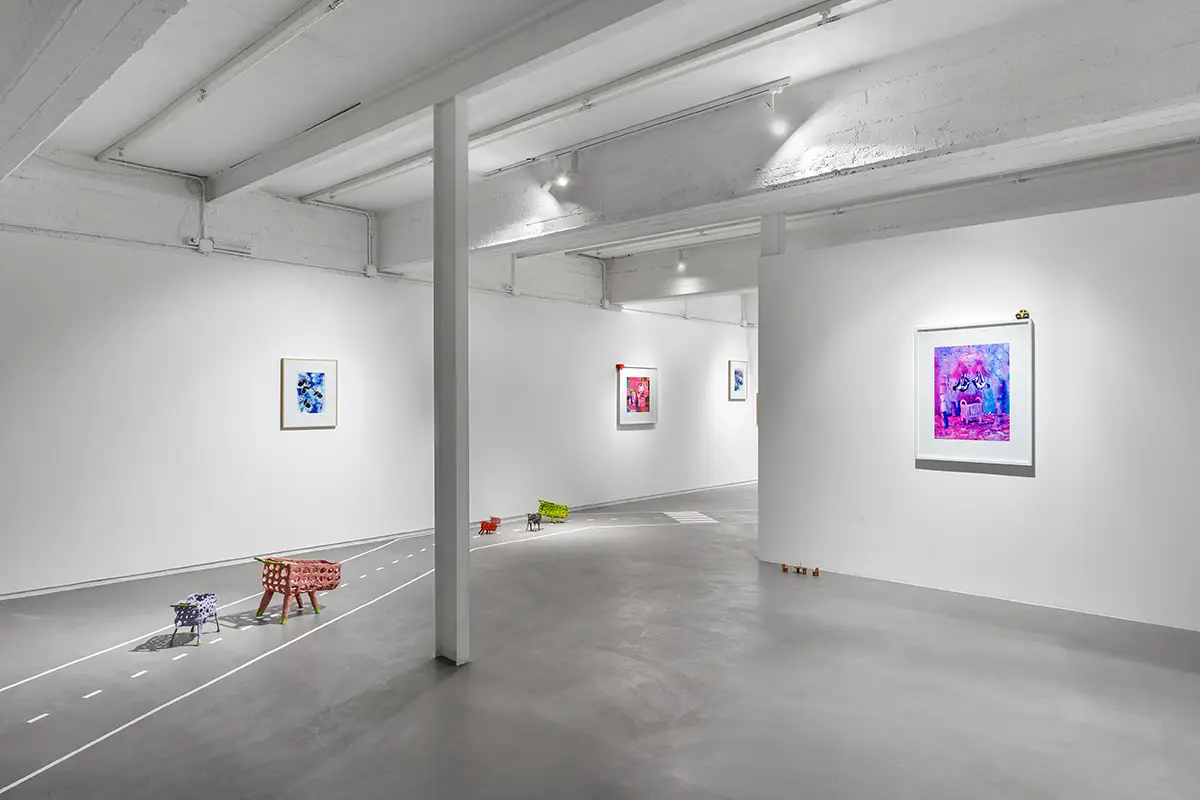ArtNoble Gallery presents Luca Staccioli’s exhibition WAKE-UP CALL, an intimate reflection on the meaning of childhood in relation to the socio-cultural environment that surrounds us
Luca Staccioli’s multidisciplinary approach
Luca Staccioli’s work as an artist starts from a need to create a narrative for the viewer. In his career he has mainly used visual media in the development of his works and exhibitions. From drawing to sculpture to those mediums that go through digital processing such as video and photography. Central element within his works is always childhood and all that surrounds it.
Often the symbols of it are placed side by side with everything that in growing up influences the formation of the individual. In a layering of meanings that above all highlights the critical aspects of contemporary society. From identity and aesthetic homogenization to the heavy weight of expectations that crushes the individual. Consumerism, productivity and competitiveness are analyzed in their intertwining with stories belonging to memory, everyday and historical images.
WAKE-UP CALL, Luca Staccioli
«As we enter the exhibition, we cannot say whether we have landed in an amusement park or whether we are on a guided tour that will lead us through an imaginary and personal tale, or whether perhaps we have just ended up in one of our most bizarre dreams», that is how Irene Sofia Comi describes the work of Luca Staccioli.
WAKE-UP CALL is also part of the reflection on childhood in relation to today’s context. The narrative used by the artist to tell his point of view is based on a sense of dislocation of objects, spaces, bodies. Works with a melancholic atmosphere take on almost caricature-like appearances, and in this case the toy-sculptures do much of the work.
Despite this sense of unsuitability to space, it still appears familiar, part of a memory perhaps distant, perhaps distorted. From the common images Staccioli creates reading planes that take on the appearance of an ideological manifesto rather than a political meaning.
Checkout and the consumerist obsession
Framing itself in a non-place between reality and imagination hybridized by childhood symbology, Staccioli’s art results in a mix of media and creative techniques. In the Checkout series using glazed ceramic elements, the cultural obsession with the trolley to be filled is investigated. It starts with memories of when the artist was a child and enjoyed sorting and perfectly fitting food inside the supermarket cart.

Reminiscences of Marino Marini
And it comes to the digitized world in which the action becomes almost automated, through the use of the mouse, which dematerialized shopping. Haphazardly, a series of trolleys of different shapes and colors follow one another in the work, seeming to mimic the tiredness of animals pointing their paws at the floor. «The larger ones are reminiscent of Marino Marini’s anti-heroes who, having lost their steed, can no longer stand as equestrian monuments», Comi explains.
While the smaller ones mimic the games that since childhood seem to want to teach us to consume. Even Castello (di sabbia?) (Castle (of sand?)) resembles a work erected to celebrate heroic deeds, but it actually brings back objects of everyday consumption. From washing machines to neatly arranged automobiles and floating office chairs. Everything fits within this sort of bas-relief that mimics another must in a childhood playground.
The photographic series: Familiar Stories (returns)
The photographic series that adorns the walls of this surreal childhood dream replays this atmosphere with an emphasis on the somber. Familiar Stories (ritorni) takes up some of the motifs traceable in the childhood of many by weaving them into a saturation of colors. Examples are the rooms in the house depicted using as furniture the very didò sculptures that are also physically found in the exhibition.
The shades of blue and purple in particular create the impression of alienating interiors that are a mix of objects made in a different way. From the bedroom with the cradle to a series of desk chairs that seem to rain from the sky in an atmosphere with dreamlike features. The protagonists of these photos are figures representing human beings placed in positions that are not at all usual, such as those hanging to represent a music box.
Luca Staccioli, Studio per una Protesta (Study for a Protest)
«These are forgotten characters, taken from images of captivity from 20th-century photographic archives», the Gallery explains. The same can also be found in the collection of drawings Studio per una Protesta (Study for a Protest). Here, nature and these beings merge to such an extent that they become real landscape elements. The hinted strokes in this series allow the viewer to be able to complete the figure in a personal way.
ArtNoble Gallery: the main aim
Founded in London by Matthew Noble, the gallery’s purpose from its itinerant beginnings has been to seek out and then to exhibit emerging artists. As of 2021, it will move on a permanent basis to Milan representing both emerging artists and more established ones from Italy and elsewhere.
The focus remains on the protagonists of contemporary art but with the aim of creating an international community capable of enhancing the talents of each country. In addition, ArtNoble Gallery provides ongoing support to artists by helping them expand internationally and explore their art.
Luca Staccioli
Visual artist and researcher active mainly in Milan, winner of the Exibart Prize 2021/2022. After his studies in painting and curating, he decided to dedicate his work to different visual forms from the digital sphere to drawing and sculpture.



















